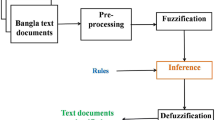Abstract
In this article, a neural network document classifier with linguistic feature selection and multi-category output is presented. It consists of a feature selection unit and a hierarchical neural network classification unit. In the feature selection unit, the candidate terms are extracted from some original documents by text processing techniques, and then the conformity and uniformity of each term are analyzed by an entropy function which can measure the significance of terms. Terms with high significance are selected as input features for training neural network document classifiers. In order to reduce the input dimensions, a composition mechanism of fuzzy relation is employed to identify synonyms. By this method, a synonym thesaurus can be constructed to reduce input dimensions. To simplify the learning scheme, the well-known back-propagation learning model is used to build proper hierarchical classification units. In our experiments, a product description database from an electronic commercial company is employed. The experimental results show that this classifier achieves sufficient accuracy to help human classification. It can save much manpower and work time classifying a large database.
Similar content being viewed by others
References
R.E. Filman and Sangam Pant, “Searching the Internet,” IEEE Internet Computing, July–August, pp. 21–23, 1998.
A. Sun, Ee-Peng Lim, “Hierarchical text classification and evaluation,” in Proceedings IEEE International Conference on Data Mining, 2001, pp. 521–528.
M.E. Ruiz and P. Srinivasan, “Hierarchical text categorization using neural networks,” Information Retrieval, vol. 5, no. 1, pp. 87–118, 2002.
M. Sasaki and K. Kita, “Rule-based text categorization using hierarchical categories,” IEEE International Conference on Systems, Man, and Cybernetics, 1998, vol. 3, pp. 2827– 2830.
R. Schettin, C. Brambilla, G. Ciocca, A. Valsasna, and M. De Ponti, “A hierarchical classification strategy for digital documents,” Pattern Recognition, vol. 35, pp. 1759–1769, 2002.
C.H. Caldas and L. Soibelman, “Automating hierarchical document classification for construction management information systems,” Automation in Construction, vol. 12, pp. 395–406, 2003.
G.P. Zhang, “Neural networks for classification: A survey,” IEEE Transactions on Systems, Man, and Cybernetics, Part C: Applications and Reviews, vol. 30, no. 4, pp. 451–462, 2000.
P. Picton, Neural Networks, Palgrave: New York, 2000.
Hsinchun Chen, Chris Schuffels, and Richard Orwig, “Internet categorization and search: A self-organizing approach,” Journal of Visual Communication and Image Representation, vol. 7, no. 1, pp. 88–102, 1996.
W.B. Frakes and R. Baeza-Yates, Information Retrieval: Data Structures & Algorithms, Prentice Hall PTR, 1992.
C. Jenkins, M. Jackson, P. Burden, and J. Wallis, “Searching the World Wide Web: An evaluation of available tools and methodologies,” Information and Software Technology, vol. 39, pp. 985–994, 1998.
V.N. Gudivada, V.V. Raghavan, W.I. Grosky, and R. Kasanagottu, “Information retrieval on the World Wide Web,” IEEE Internet Computing, September–October, pp. 58–68, 1997.
Ron Sun and L.A. Bookman, Computational Architectures Integrating Neural and Symbolic Processes: A Perspective of the State of the Art, Kluwer Academic Publishers, 1995.
Stefan Wermter and Ron Sun, Hybrid Neural Systems, Springer-Verlag Telos, 2000.
G. Salton, Automatic Text Processing: The Transformation, Analysis, and Retrieval of Information by Computer, Addison Wesley, 1989.
M.F. Wyle and H.P. Frei, “Retrieval algorithm effectiveness in a Wide Area network information filter,” in Proc. of the 14th ACM SIGIR Conf. on R&D in Information Retrieval, ACM, Chicago IL, 1991, pp. 114–122.
M.E. Porter, Competitive Strategy: Techniques for Analyzing Industries and Competitors, Free Press: New York, 1980.
W. Francis and H. Kucera, Frequency Analysis of English Usage, New York, 1982.
C.E. Shannon, “A mathematical theory of communication,” Bell System Technical Journal, vol. 27, pp. 279–423, 1948.
Y. Yang, C.G. Chute, and M. Clinic, “An example-based mapping method for text categorization and retrieval,” ACM Transaction on Information Systems, vol. 12, no. 3, pp. 252–277, 1994.
M.T. Hagan, B. Demuth Howard, and H. Beale Mark, Neural Network Design, Martin HaganJan: Stillwater, 2002.
G.J. Klir and B. Yuan, Fuzzy Sets and Fuzzy Logic: Theory and Applications, Prentice Hall: NJ, 1995.
Y.-L. Huang, “A theoretic research of cluster indexing for mandarin chinese full text document—the construction of vector space model,” Journal of Library and Information, vol. 24, pp. 44–68, 1998.
Rothlauf and Franz, Representations for Genetic and Evolutionary Algorithms, Heidelberg, Physica-Verlag, 2002.
M.S. Bazarara, H.D. Sherali, and C.M. Shetty, Nonlinear Programming Theory and Algorithms, John Wiley & Sons: New York, 1993.
Yi-Cheng Ye, Applications and Implementation of Neural Network Models, Ru-Lin, 1998.
Dunham Margaret H., Data Mining Introductory and Advanced Topics, N.J.: Prentice Hall/Pearson Education, 2003.
M. Torii and M.T. Hagan, “Stability of steepest descent with momentum for quadratic functions,” IEEE Transactions on Neural Networks, vol. 13, no. 3, pp. 752–756, 2002.
L. Mohan Saini and M. Kumar Soni, “Artificial neural network-based peak load forecasting using conjugate gradient methods,” IEEE Transactions on Power Systems, vol. 17, no. 3, pp. 907–912, 2002.
G. Lera and M. Pinzolas, “Neighborhood based levenberg-marquardt algorithm for neural network training,” IEEE Transactions on Neural Networks, vol. 13, no. 5, pp. 1200–1203, 2002.
T. Kimoto and K. Asakawa, “Stock market predication system with modular networks,” in IJCNN-90, 1990, vol. 1, pp. 1–6.
Y.-C. Hou and S.-H. Yang, “A study on automatic document classification by combine fuzzy theory and genetic algorithms,” Journal of Fuzzy Systems, vol. 4, no. 1, pp. 45–57, 1998.
Y.-Y. Yang, “Document Automatic Classification and Ranking,” Master Thesis, Department of Computer Science, National Tsing Hua University, Hsinchu, Taiwan, June 1993.
R.M. Friedberg, “A learning machine: Part I,” IBM Journal, vol. 2, pp. 2–23, 1958.
F. Limin, Neural Networks in Computer Intelligence, McGraw Hill, 1994.
Author information
Authors and Affiliations
Corresponding author
Rights and permissions
About this article
Cite this article
Chen, CM., Lee, HM. & Hwang, CW. A Hierarchical Neural Network Document Classifier with Linguistic Feature Selection. Appl Intell 23, 277–294 (2005). https://doi.org/10.1007/s10489-005-4613-0
Issue Date:
DOI: https://doi.org/10.1007/s10489-005-4613-0




